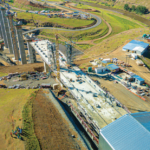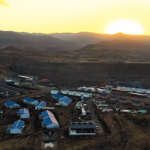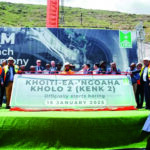Staff Reporters
A team of the Lesotho Highlands Development Authority (LHDA) senior engineers, tunnel expert consultants including contractors was recently in China to inspect the Tunnel Boring Machines (TBMs) ahead of their arrival into the country later this year.
The 5.39-meter diameter TBMs, with 415-meter backup systems, are specifically being manufactured at a CCCC Tianhe plant in Changshu City, Jiangsu Province, China for the excavation of the 38-km transfer tunnel from Polihali to Katse.
The inspection, which took place from May 8 to 11 this year, sought to ensure that the TBMs met the specifications for the excavation of the Polihali transfer tunnel.
The massive TBMs have been specifically designed to handle the challenging basalt rock formations in the Mokhotlong and Leribe districts where the transfer tunnel is being constructed.
The Polihali to Katse Transfer Tunnel is one of the main works components of Phase II of the Lesotho Highlands Water Project (LHWP), and its construction is already underway by Kopano Ke Matla Joint Venture.
The inspection, which is also known as the factory acceptance test was conducted by LHDA senior engineers, representatives from Metsi a Senqu Khubelu Consultants (MSKC), the Kopano Ke Matla Joint Venture, and the TBM designer, Robbins.
MSKC designed the tunnel and provided the TBM specifications, while Robbins, a U.S. company, designed the machines.
“We verified the design of the TBMs, their functionality, and adherence to safety standards. This included examining the cutter heads, backup systems, and segment erection mechanisms,” said Neo Thinyane, the LHWP Phase II Senior Projects Engineer.
The team also assessed the functionality of the muck removal system, conveyor belts, power supply, ventilation, water supply, and dewatering systems. Safety features were a primary focus of the acceptance test.
“We checked for adequate walkways, head clearance and body width for workers, gas detection systems for hazardous gases like methane, and the functionality of alert alarms,” Thinyane emphasised.
Fire detection and suppression systems were also scrutinised, given the risky nature of tunnel excavation and TBM operations, as were the crucial safe extraction procedures. The TBMs are equipped with refuge bays containing life-support systems, including first-aid kits, oxygen tanks, respirators, and air filtration systems. Additionally, there are backup power and cooling systems to ensure uninterrupted operation in case of power outages.
The Polihali Transfer Tunnel will transfer water by gravity from the Polihali Reservoir to the Katse Reservoir. The excavation will utilise both tunnel boring and drill and blast methods from both ends.
The Polihali Transfer Tunnel works include the intake works and gate shaft at the Polihali reservoir, outlet works, and gate shaft at the existing Katse reservoir with an underwater connection to the lake, and access adits to the waterway and associated construction infrastructure.
Notable progress has been made on the intake, outlet works, and access adits.
Summary
- The inspection, which took place from May 8 to 11 this year, sought to ensure that the TBMs met the specifications for the excavation of the Polihali transfer tunnel.
- The Polihali to Katse Transfer Tunnel is one of the main works components of Phase II of the Lesotho Highlands Water Project (LHWP), and its construction is already underway by Kopano Ke Matla Joint Venture.
- The Polihali Transfer Tunnel works include the intake works and gate shaft at the Polihali reservoir, outlet works, and gate shaft at the existing Katse reservoir with an underwater connection to the lake, and access adits to the waterway and associated construction infrastructure.

Your Trusted Source for News and Insights in Lesotho!
At Newsday Media, we are passionate about delivering accurate, timely, and engaging news and multimedia content to our diverse audience. Founded with the vision of revolutionizing the media landscape in Lesotho, we have grown into a leading hybrid media company that blends traditional journalism with innovative digital platforms.









